Re: [Rotbrett] I flew my wingsuit into trees... and woke up in a hospital!
+1, and great example!
After watching Eric's video
over 9000 times and reading the interview over the couple of days, I came to a very different conclusion than a quick initial dismissive one, "Eh, just another idiot who wanted to be a youtube star, too soon, too quick". I think Eric can ease up beating himself so hard and deserves a bit of a rehabilitation.
(Note: the youtube video in the article is sped up and is not particularly useful for us; watch the raw version:
http://topgunbase.ws/.../10/540-Med-Eric.mp4)
The more I watched the video and read Eric's description, the more it all made sense together. So, let's go slowly, step by step.
He starts good, at 0:22 timecode. No problem here. At 0:41 in video (19s in flight) he passes final pillars on the right and soon after flies into open air, and he has a healthy amount of forward speed. Nothing seems unusual here.
Then,
"My idea was to fly a right line towards the refuge to test how different inputs would improve my approach for a fly by. I’d aim toward the mid-station, and see how high I was flying." - we see (and hear) him slowing down considerably. He's looking forward, at the Impact Point (IP) - the starfield effect epicenter. He's evaluating if he can fly over the refuge (and possibly into Le Blaitiere line?) Aiming a bit to the right of the refuge - toward the cable car mid-station. He is testing if this flight mode will get him there high enough to proceed. So far, all goes as intended.
Looks like he wants to fly at sustained max L/D to get to the mid-station as high as possible, but trades too much of horizontal speed into better glide ratio - which is only temporary, as basic wingsuit physics tells us that to have GR > L/D, you have to be decelerating. Essentially, he does a slow, almost unnoticeable flare after passing the pillars, and rides high GR of this flare. Like slowly giving rear riser or brake input under canopy - except with wingsuit, this slow flare can last much longer than under canopy, due to higher wingloading. But not forever.
He spends quite some time in this flight mode (possibly tweaking configuration to see the effect), until about 1:25 (63s flight time) where it's obvious the IP is way below the mid-station - he cannot make it. No problem - he used the "skydive" portion of the jump to do some safe experiments, which should be applauded.
"If I didn’t like how high I was, I would just turn left to fly Cheese Grater line instead. As it turned out, I noticed early that I’d be too low to fly over the refuge, so I flew Cheese Grater" So far, it goes by the decision tree he planned ahead. He turns into Cheese Crater (sp?) line and picks up speed as he is diving under the wires. The speed at entrance seems to be healthy enough, it doesn't immediately scream "too slow, abort!" Now we know that it doesn't have a
healthy margin above that
minimum passable speed, but it looks passable:
"At that moment, I actually felt fine to turn onto the Cheese Grater line. Based on my previous jumps on that line, I honestly thought I would have no problems." Let's compare waypoints as Rotbrett suggested. Here's pretty much the same point, except Eric is a bit more to the left - 1:45 in Eric's video and 0:02 in the other.
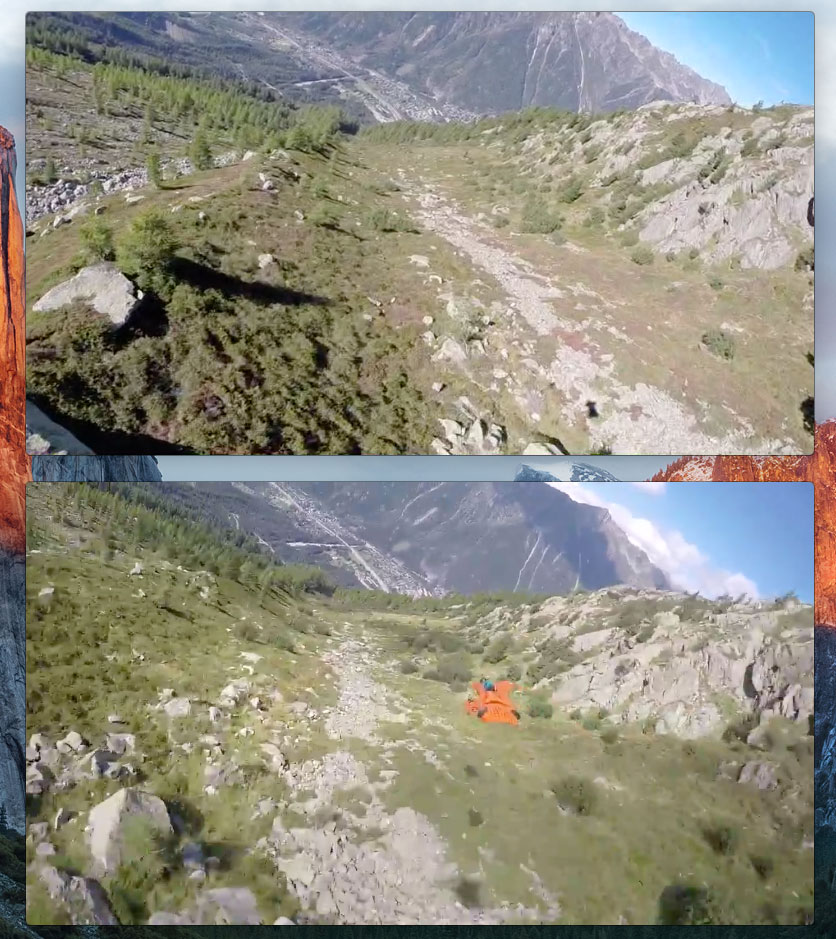
Exactly 10s later they're at exact same spot above the switchback of the trail:
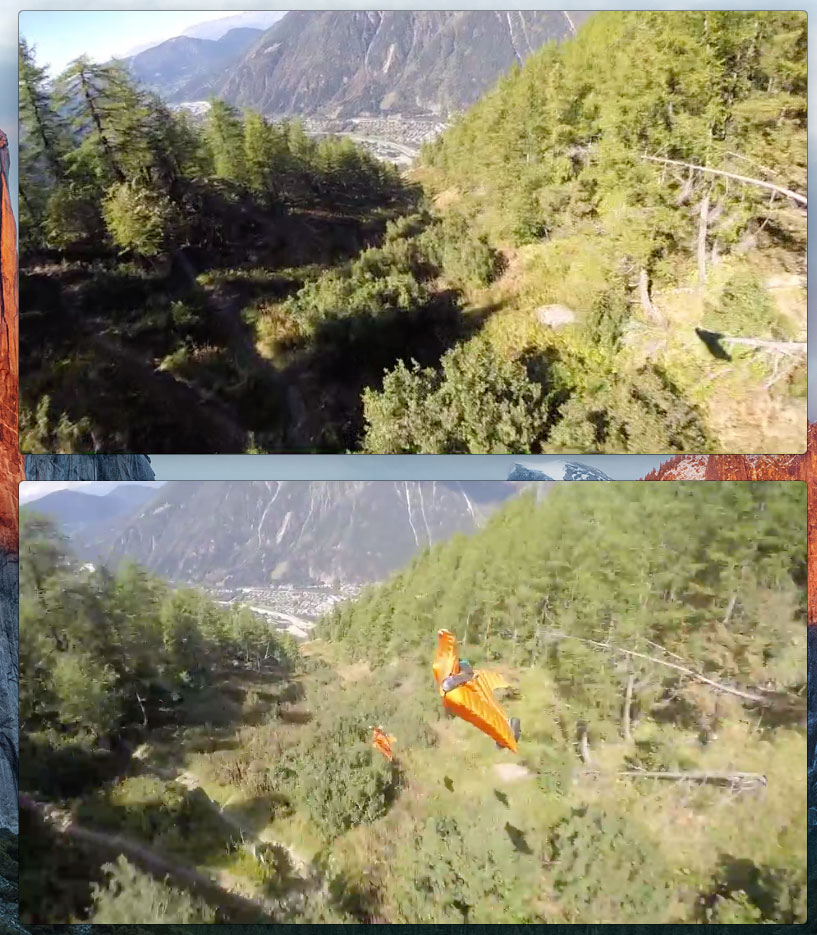
Judging by the shadow, Eric is fully stretched, flat as a plank, arms in some dihedral for more speed. Doesn't look head-high. It all doesn't look troublesome so far. Everything is almost exactly the same as in the other video.
4 more seconds later, same spot:
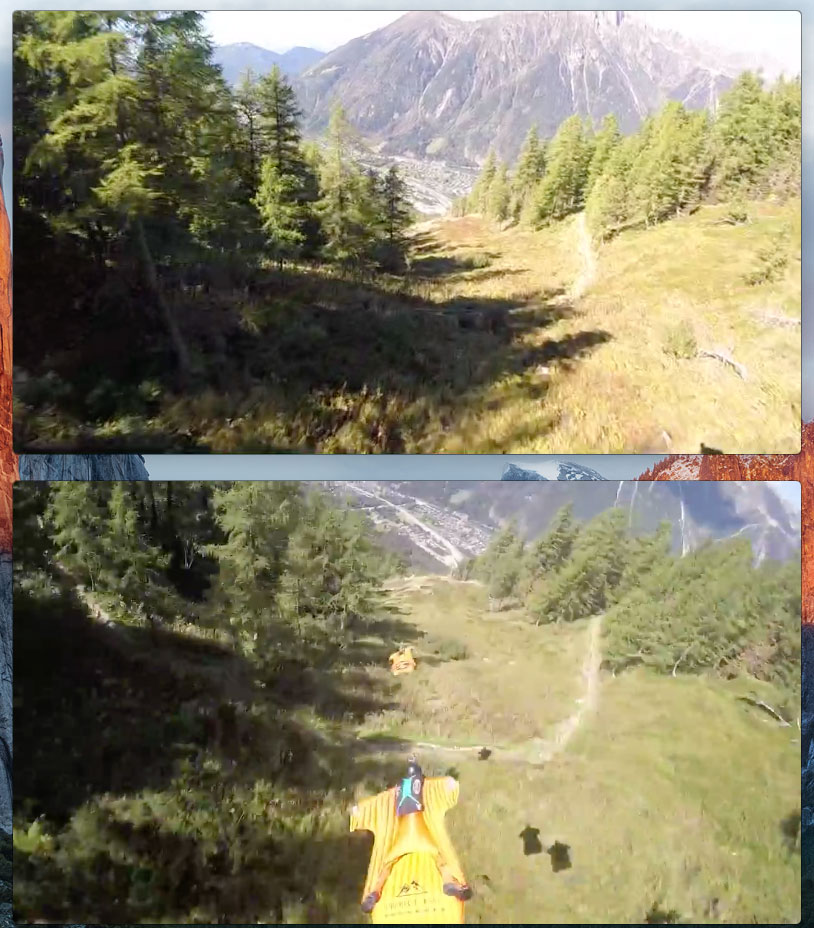
And only then he slows down slightly, here's the same spot where he's at 19s, vs 18s for other guys:
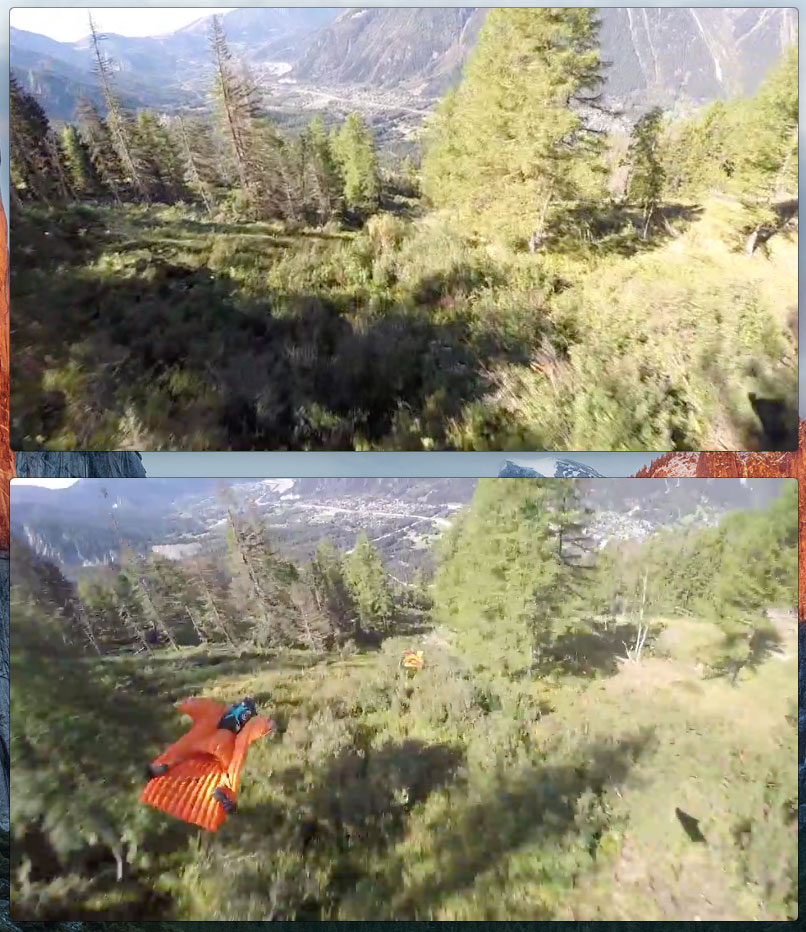
The 1-second lag continues to the point where he starts flying out of the ditch while the orange guys continue farther into it. Now, with lower speed, he flattens his glide, which results in... (physics!) more lost speed.
"- As you’re watching your POV video of this flight [5 sec prior to impact], do you feel you have the speed to aggressively flare and get out of this line?
- No, not at all. I was actually expecting to continue flying straight and have the trees drop out from underneath me.
- Was this a normal flight condition for you on this line?
- Honestly, yeah… Cheese Grater is sort of a flat-ish line. But I had always disconnected at a certain point about halfway down, and I always made my normal LZ." So if we only think about why he got into trouble and the other guys did not, we conclude that he lost some speed at the bottom portion of his line most likely due to maneuvering between the trees and doing little (very little!) flares when he felt a bit too close to the ground, and finally did a bit too much flare (but still, a small flare) while disconnecting, while the other guys continued down and kept their speed.
So, in relative terms, he made only a very small mistake, compared to the other video, but it lead to a dramatically different outcome.
The logical conclusion is that in both cases, speed was not sufficient enough to provide sufficient margin, in both cases, margin for error was nearly zero. It's just Eric dipped a bit below it. His 10 or so jumps before this one were just like the other guys'. So he thought good about it.
"- Looks like you had an ‘out’ to the left about 10 seconds prior to impact, and you didn’t take it. Why?
- I hadn’t planned for an ‘out’. I honestly didn’t expect to need one. I was just thinking about flying straight to my normal LZ. In hindsight, I think I was stuck on my ‘gameplan’ and obviously didn’t have the awareness to adjust inflight, especially when staying in the line longer than normal." "It wasn’t until about the last 5 seconds that I felt the trees below me getting closer than I expected or wanted. Everything before that felt flyable to me." Sans the small mistake near the end of flight, it looks like Eric's flying was exactly like a lot of other jumpers fly it.
(When watching various proximity videos which look faster than this, take into account the cinematic distortion of some lenses or in post processing which makes footage look faster than it actually is; also, time of day/light conditions: the lower the light, the longer the exposure of each frame, which smears it more and makes impression of greater speed.)
Now, let's talk about experience.
"Currently, I’ve been skydiving for 4 years (900 total / 550 wingsuit), and basejumping for 2 years. I only have about 80 slider-off jumps, about 40 tracking jumps, and 105 WS base jumps." Not shabby at all. I'd say, appropriate for some cautious proximity. Flying high enough above Cheese Crater? - Why not. Flying this close? Not a good idea. But overall, this amount of experience does not raise a red flag. His starts are solid. Just continue "skydiving" off the Midi, with very cautious brief proximity here and there, and he'd be fine.
So, these arguments, in my mind, changed my opinion from dismissive to... "hmm, can we actually learn something deeper here rather than just kicking the 'dead man walking'"? Because it looks like there are many, many jumpers flying like this, not understanding THAT and WHY they have virtually zero margin of error.
What many do not realize is that total speed alone is
not an indicator of a healthy flight. To saying "fly fast" we must always - ALWAYS! - add "...horizontally". Never just say "fly fast". Always say "fly fast HORIZONTALLY". This is because wingsuit dynamics works in such a way that to a given
total airspeed there can correspond many very different flight modes. Including modes that have no ability to detach from the line at will.
Imagine a thought experiment. Same pilot does proximity over some very smooth grassy slopes with no features that would indicate how steep the slope is. In one case, he's flying 120mph forward, 80mph down (1.5:1 slope), his total speed along the slope is 144mph (120*120 + 80*80 = 144*144). In the other, he's flying 102mph forward, 102mph down (1:1 slope), his total speed along the slope is 144mph (102*102 + 102*102 = 144*144). Pythagorus, the best wingsuiter's friend.
In both cases, his total speed is the same. The buzzing grass below will be zooming past equally fast. And because it's impossible to tell exactly what slope is, the flights will feel about the same (in first-person POV video - virtually indistinguishable). Even body configuration can be the same: say, arms in some dihedral, body line pitched 5 degrees below horizon. But the flight modes are different: L/D = 1.5, AoA = atan(1/1.5) - 5 = 34 - 5 = 29 degrees in the former; L/D = 1.0, AoA = atan(1/1) - 5 = 45 - 5 = 40 degrees in the latter. The latter mode, at 40 degrees angle of attack, is actually an aerodynamic stall, while the former, at 29, while is still aerodynamically "dirty", but not quite a stall-stall, at least in wingsuiting sense.
Here's a little illustration: Wingsuit Polar Region - an area on horizontal-vs-vertical
sustained (important!) speed graph where a wingsuit pilot can be, and cannot be outside of it no matter what (in sustained flight, i.e. strictly constant both horizontal and vertical speed, indefinitely; of course, dynamic maneuvers allow achieving speeds outside of WPR, but only briefly.)
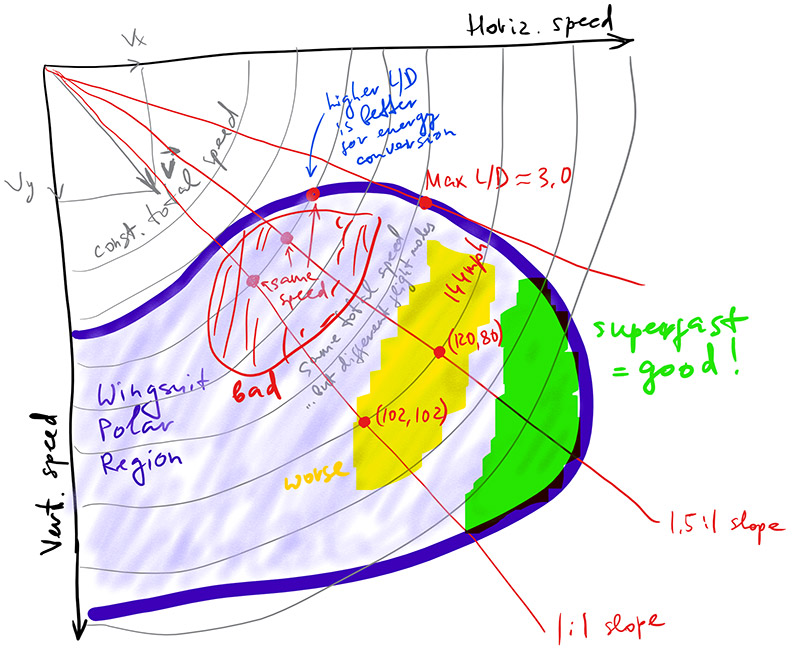
Circle lines represent constant total speed, and we can see from their intersections with WPR that there can be many, many very different flight configurations with the same total airspeed.
Ability to climb out depends not only on total speed, but in greater extent on L/D, so that L/D = 1.5 will have greater ability to convert speed to detachment from the line than 1.0. Poor L/D = poor ability to utilize speed for life-saving or fun purposes; high L/D opens many possibilities. Rising L/D from low 2-ish of early wingsuits to 3.0 of modern suits is what makes the latter so capable of powerful flare - not the size by itself! But 3.0 is still not enough to, for example, make a Nesterov's loop using no engine other than gravity - for that, you need something closer to 10. Paragliders with L/D~6-8 can do just a tiny, not well-formed loop, while hangliders with L/D~10+ can do a much more pronounced loop; gliders with L/D=30+ can do a perfect circle very easily.
This illustrates a BASE jump in polar graph with various constant L/D's: jumper starts at the origin (zero speed) and the lines with L/D = 0.5...3.567 show how horizontal and vertical speeds change - higher L/D results in better natural planeout (i.e. lower min vertical speed, higher max GR):
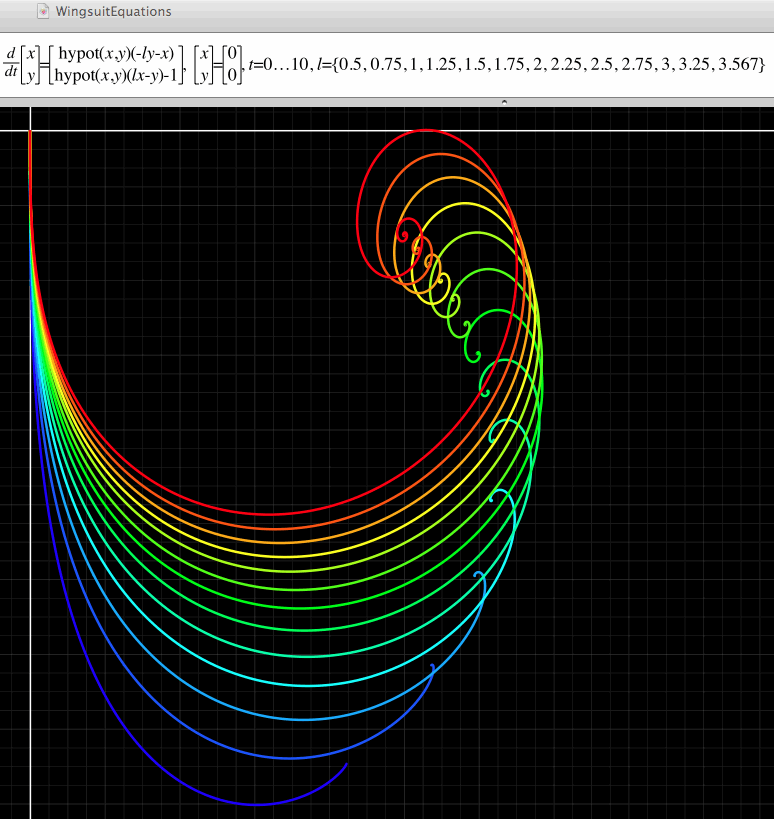
So, while in both cases total speed is the same, 144mph (looks decent fast, right?), the pilot flying steeper terrain - paradoxically - will have lesser ability to detach than the pilot flying shallower terrain, because his L/D is so poor that he's essentially in a stall, while the second is at L/D 1.5, which has more "oomph" for flare. (although, of course, steeper terrain will drop down below the pilot faster)
Now, the right, safe(-ish) way to fly in this example is not at 144mph, but at much higher total speed, at the right-bottom-most region of the WPR where the slope intersects the WPR envelope, not the left-top-most region. This will give the pilot much much more kinetic energy to covert to potential energy when needed.
Also, it's better to fly fast with zero dihedral, not sweeping arms back, but instead achieving high speed by reducing AoA. If AoA is very very small, not only you're superfast, but you have more room for AoA to increase when you need it. If AoA is not small and you achive fast flying by sweeping your arms back, you leave little room for AoA increase.
These examples demonstrate the "polymorphic" nature of wingsuit dynamics: you can be flying in exact same configuration, what looks and sounds to you like exact same speed, what looks on video (even outside one) quite typical, but actually in very different (aerodynamically) flight modes with completely different margins of error in terms of detachability.
And this, I think, is a very important point to make and is the whole reason why I wrote such a long post. Not knowing this point is a trap which can lead many pilots to trouble, like it did with Eric.
This is the mechanism that can trap pilots in thinking that their flying is ok, because the visuals and hearing tell them that their speed is decent enough. But it actually is not.
Flying just fast is not enough, it's not enough to rely on just the sensation of speed, because we cannot intuitively (without instrumentation) break total speed into its horizontal and vertical components. It's important to fly fast HORIZONTALLY, with whatever vertical speed comes with it. The solution to this is to fly DELIBERATELY SUPERFAST, well in the right-bottom envelope of the polar region. Cannot fly superfast? Abort the flight NOW! Either peel off now while you can, or pull now if you're high, but do not continue into the line - it's now a zero-margin trap. Eric, get well - superfast!





 ) very high above the lines, with all means of ensuring that you're not only flying fast, but constantly accelerating - roar of air, visuals, video analysis by waypoints, GPS and other flying magic
) very high above the lines, with all means of ensuring that you're not only flying fast, but constantly accelerating - roar of air, visuals, video analysis by waypoints, GPS and other flying magic  . Only when you can do it with 146% consistency, start slowly lowering your flight. The rule must be, you always exit the line with higher speed that you started it - ideally, through smooth acceleration from GE speed to max possible speed at the intersection of the slope line and WPR envelope. This will probably be even more difficult to master than very steep and fast low AoA flight - it's kind of unnatural to accelerate -and- maintain constant GR, we're more used to "milking" our speed/deceleration to have constant, elevated GR, but once it's mastered, I think it will be the safest way to do proximity.
. Only when you can do it with 146% consistency, start slowly lowering your flight. The rule must be, you always exit the line with higher speed that you started it - ideally, through smooth acceleration from GE speed to max possible speed at the intersection of the slope line and WPR envelope. This will probably be even more difficult to master than very steep and fast low AoA flight - it's kind of unnatural to accelerate -and- maintain constant GR, we're more used to "milking" our speed/deceleration to have constant, elevated GR, but once it's mastered, I think it will be the safest way to do proximity.  Fig B configuration should already be fast enough and safe for disconnect; next second, he's only faster and even more safe to disconnect; next second... and so on. By the line finish time, he's built up tremendous speed and is in squeaky clean aerodynamic shape at low AoA, disconnects easily and shoots up the sky like a jet, finishing with a soft "go-n-throw" deployment.
Fig B configuration should already be fast enough and safe for disconnect; next second, he's only faster and even more safe to disconnect; next second... and so on. By the line finish time, he's built up tremendous speed and is in squeaky clean aerodynamic shape at low AoA, disconnects easily and shoots up the sky like a jet, finishing with a soft "go-n-throw" deployment. 









